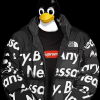no.. just no


NigelFrobisher, Needs JSON embedded in the elements because JSON is best practice.
Reptorian, I kind of like it. I can understand where it start and end.
BoastfulDaedra, I haven’t been this pissed off since LINQ started allowing syntax switches in random-ass places.
SaltyIceteaMaker, 
got no clue abot sql. what is wrong and how is it supposed to look like?
schnurrito, SQL is supposed to look like this: SELECT status, name FROM some_table LIMIT 5
ILikeBoobies, (edited ) Different language
Daxtron2, this basically xml being made to look like SQL. It’s gross and that’s why it’s funny
traches, SQL is run on the server to communicate with a database. The screenshot is jsx, which is a front-end, UI templating language. Writing SQL this way is cursed
SirQuackTheDuck, It could be querying the in-browser database (that’s commonly used, such as with WhatsApp web), which would be seeded by a different part of the application
utopianfiat, Except that’s still a SQL dialect, not JSX. There’s no need to make this JSX.
RagingRobot, It’s kind of like graphQl you could make a compiler that would work with this.
utopianfiat, but why
httpjames, 
Joins must be a pain in the ass with hooks
dylanTheDeveloper, 
Omg that’s terrible! Link?
akash_rawal, I actually like this. This would allow reuse of all the infrastructure we have around XML. No more SQL injection and dealing with query parameters? Sign me up!
CanadaPlus, Assuming it’s built well. As someone else pointed out, it doesn’t look quite right here.
utopianfiat, So you mean like parameterized queries, which exist?
akash_rawal, Better than parameterized queries. Yes, we have stuff like
query(“INSERT INTO table(status, name) VALUES ($1, $2);”).bind(ent.status).bind(ent.name).execute…, but that’s kind of awful isn’t it? With XML queries, we could use any of the XML libraries we have to create and manipulate XML queries without risking ‘XML injection’. e.g we could convert ordinary structs/classes into column values automatically without having to use any ORM.
docAvid, (edited ) I mean, that’s just a bad library interface. With a halfway decent interface, you can do something like
<span style="color:#323232;">query('insert into foo (status, name) values (:status, :name)', ent) </span>No orm required. With tagged templates in JS, you can do
<span style="color:#323232;">q`insert into foo (status, name) values (${ent.status}, ${ent.name})` </span>Even wrap it in a function with destructuring to get rid of
ent:<span style="color:#323232;">const addFoo = (q, {status, name}) => </span><span style="color:#323232;"> q`insert into foo (status, name) values (${status}, ${name})` </span>Typescript can add type safety on top of that, of course. And there’s the option to prepare a query once and execute it multiple times.
Honestly, the idea of manipulating XML queries, if you mean anything more fancy than the equivalent of parameter injection, sounds over-complicated, but I’d love to see a more concrete example of what you mean by that.
akash_rawal, (edited ) I was thinking along the lines of
https://lemmy.world/pictrs/image/4ef7f59c-88c7-4cfa-8dd5-91c71d8ad801.jpeg
Plenty of libraries can build the XML using structs/classes. e.g. with serde:
<span style="font-style:italic;color:#969896;">//Data type for row </span><span style="color:#323232;">#[derive(serde::Serialize)] </span><span style="font-weight:bold;color:#a71d5d;">pub struct </span><span style="color:#323232;">Foo { </span><span style="color:#323232;"> </span><span style="font-weight:bold;color:#a71d5d;">pub </span><span style="color:#323232;">status: String, </span><span style="color:#323232;"> </span><span style="font-weight:bold;color:#a71d5d;">pub </span><span style="color:#323232;">name: String, </span><span style="color:#323232;">} </span><span style="color:#323232;"> </span><span style="font-style:italic;color:#969896;">//Example row </span><span style="font-weight:bold;color:#a71d5d;">let</span><span style="color:#323232;"> ent </span><span style="font-weight:bold;color:#a71d5d;">=</span><span style="color:#323232;"> Foo { </span><span style="color:#323232;"> status: </span><span style="color:#183691;">"paid"</span><span style="color:#323232;">.</span><span style="color:#62a35c;">into</span><span style="color:#323232;">(), </span><span style="color:#323232;"> name: </span><span style="color:#183691;">"bob"</span><span style="color:#323232;">.</span><span style="color:#62a35c;">into</span><span style="color:#323232;">(), </span><span style="color:#323232;">} </span><span style="color:#323232;"> </span><span style="font-style:italic;color:#969896;">//Example execution </span><span style="color:#323232;">sqlx::query(</span><span style="font-weight:bold;color:#a71d5d;">&</span><span style="color:#323232;">amp;serde_xml_rs::to_string(</span><span style="font-weight:bold;color:#a71d5d;">&</span><span style="color:#323232;">amp;InsertStmt{ </span><span style="color:#323232;"> table: </span><span style="color:#183691;">"foo"</span><span style="color:#323232;">.</span><span style="color:#62a35c;">into</span><span style="color:#323232;">(), </span><span style="color:#323232;"> value: </span><span style="font-weight:bold;color:#a71d5d;">&</span><span style="color:#323232;">amp;ent, </span><span style="color:#323232;">})</span><span style="font-weight:bold;color:#a71d5d;">?</span><span style="color:#323232;">).</span><span style="color:#62a35c;">execute</span><span style="color:#323232;">(</span><span style="font-weight:bold;color:#a71d5d;">&</span><span style="color:#323232;">amp;conn)</span><span style="font-weight:bold;color:#a71d5d;">?</span><span style="color:#323232;">; </span>Or with jackson-dataformat-xml:
<span style="font-style:italic;color:#969896;">//Data type for row </span><span style="font-weight:bold;color:#a71d5d;">public class </span><span style="color:#0086b3;">Foo </span><span style="color:#323232;">{ </span><span style="color:#323232;"> </span><span style="font-weight:bold;color:#a71d5d;">public</span><span style="color:#323232;"> string status; </span><span style="color:#323232;"> </span><span style="font-weight:bold;color:#a71d5d;">public</span><span style="color:#323232;"> string name; </span><span style="color:#323232;">} </span><span style="color:#323232;"> </span><span style="font-style:italic;color:#969896;">//Example row </span><span style="color:#0086b3;">Foo</span><span style="color:#323232;"> ent </span><span style="font-weight:bold;color:#a71d5d;">= new </span><span style="color:#0086b3;">Foo</span><span style="color:#323232;">(); </span><span style="color:#323232;">foo.status </span><span style="font-weight:bold;color:#a71d5d;">= </span><span style="color:#183691;">"paid"</span><span style="color:#323232;">; </span><span style="color:#323232;">foo.value </span><span style="font-weight:bold;color:#a71d5d;">= </span><span style="color:#183691;">"bob"</span><span style="color:#323232;">; </span><span style="color:#323232;"> </span><span style="font-style:italic;color:#969896;">//Example execution </span><span style="color:#0086b3;">XmlMapper</span><span style="color:#323232;"> xmlMapper </span><span style="font-weight:bold;color:#a71d5d;">= new </span><span style="color:#0086b3;">XmlMapper</span><span style="color:#323232;">(); </span><span style="color:#0086b3;">String</span><span style="color:#323232;"> xml </span><span style="font-weight:bold;color:#a71d5d;">=</span><span style="color:#323232;"> xmlMapper.writeValueAsString(</span><span style="font-weight:bold;color:#a71d5d;">new </span><span style="color:#0086b3;">InsertStmt</span><span style="color:#323232;">(</span><span style="color:#183691;">"foo"</span><span style="color:#323232;">, ent)); </span><span style="font-weight:bold;color:#a71d5d;">try </span><span style="color:#323232;">(</span><span style="color:#0086b3;">Statement</span><span style="color:#323232;"> stmt </span><span style="font-weight:bold;color:#a71d5d;">=</span><span style="color:#323232;"> conn.createStatement()) { </span><span style="color:#323232;"> stmt.executeUpdate(xml) </span><span style="color:#323232;">} </span>I don’t do JS (yet) but maybe JSX could also do similar things with XML queries.
No more matching $1, $2, … (or
?for mysql) with individual columns, I could dump entire structs/objects into a query and it would work.
normalexit, This idea is bad and whoever came up with it should feel bad.
III, It never ceases to amaze me how far idiots will go to avoid learning the most simple things. SQL isn’t hard, people’s difficulty with it says a lot more about them than it does SQL.
emptyother, People think in different ways. What might seem logical to you might look alien to another. I know SQL well enough to optimize queries, but I find it a lot easier to think about and write queries as LINQ methods. A lot more cleaner and logical to my brain.
MonkderZweite, Neither is sending form data to the server without any JS. It’s more robust too. Yet almost no form on the web works without JS.
mvirts, Remember kids, JSX is just function calls. It can’t hurt you.
Thcdenton, Oh it can and it did.
mlg, 
“HTTP and the Web is a totally reliable and easy to use internet protocol”
expr, Not only is this really gross, it’s also straight up wrong. It’s missing a from clause, and it makes no sense for a where clause to be nested under the select. The select list selects columns from rows that have already been filtered by the where clause. Same for the limit.
Also just gonna go ahead and assume the JSX parser will happily allow SQL injection attacks…
nephs, Booooo
CanadaPlus, I like the format, though.
ReluctantMuskrat, Clearly you’ve not had to write and maintain much XML.
CanadaPlus, I have not. I just thought it looks less goofy than a nested SQL statement split over multiple lines.
What are the issues with XML?
adhocfungus,
gravitas_deficiency, I want to hate this. I really do. But the problem is… I think I like it.
lorty, 
This needs a bit of work but it could be interesting
naonintendois, But how do I know if the WHERE clause is AND or OR?
gravitas_deficiency, (edited ) Fair. The constraint nodes should probably exist under an
AndorOrnode.
akash_rawal, We can say default is
andand add anOrnode foror. Similar to SoP notation, you only write+.
victorz, How about an
orboolean attribute.
Thcdenton,
Add comment